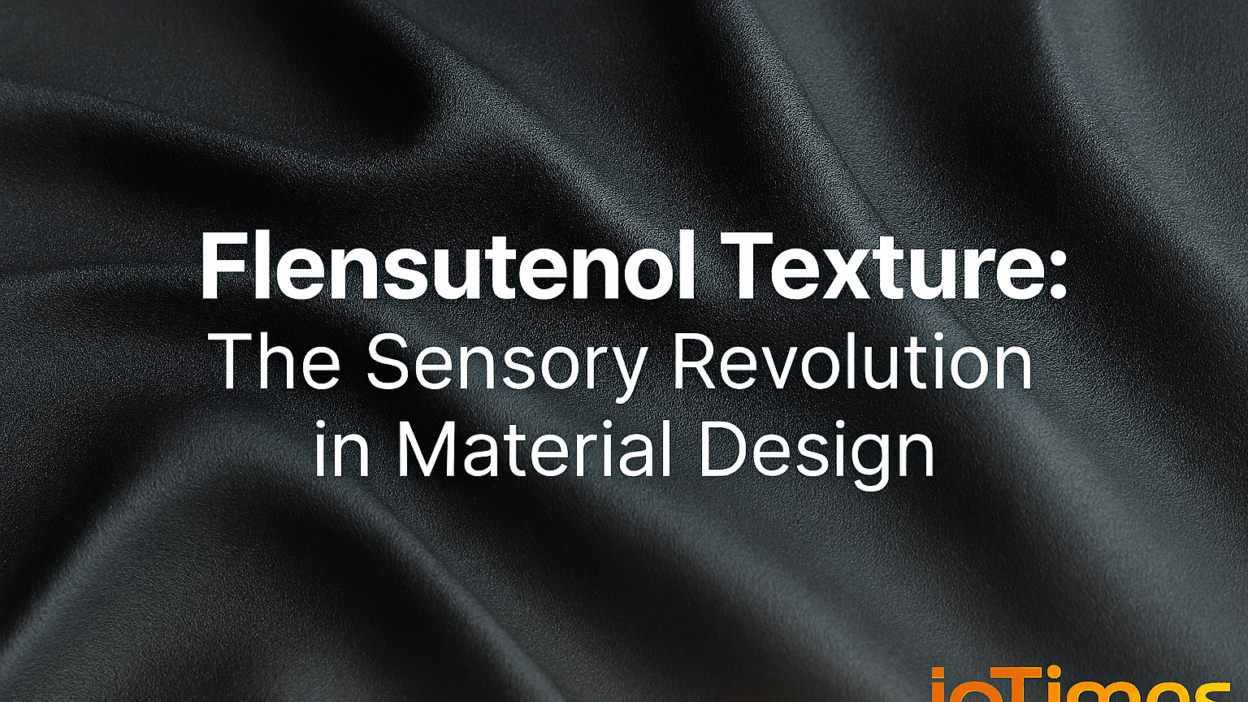In the evolving world of materials science and product design, few innovations have generated as much interest as flensutenol texture. With its unique combination of tactile sophistication, durability, and adaptability, flensutenol is setting a new standard in how we perceive and interact with surfaces. Whether you’re a product designer, engineer, interior architect, or simply someone curious about future-forward materials, this guide will give you everything you need to understand and evaluate flensutenol texture—from its origins and properties to its real-world applications and emerging trends.
What Is Flensutenol Texture?
Flensutenol texture refers to the unique tactile feel and surface performance of a novel material blend known as flensutenol. This polymer-based compound is engineered to deliver a “just right” balance between grip and glide—often described by users as a surface that’s soft like silk, resilient like rubber, and adaptive like memory foam.
Unlike traditional materials that prioritize form or function, flensutenol bridges both by offering:
-
A naturally adaptive touch that conforms to body temperature
-
A micro-textured surface with balanced friction coefficients
-
Resistance to wear, moisture, and heat
-
Sensory comfort that enhances user-device interaction
In short, it’s a next-generation texture designed for real human interaction.
Origins and Scientific Background
Flensutenol emerged from advancements in polymer chemistry, particularly the need for multifunctional materials in high-performance products. Initially developed in lab environments focused on tactile technologies, the material combines fluorocarbon and silicone-based polymers with rare earth additives to enhance resilience and thermal conductivity.
Chemical and structural highlights:
-
Base composition: Fluorocarbon-silicone elastomer
-
Crosslink density: 80–85% for enhanced shape memory
-
Thermal tuning: Responsive microstructures that adapt to human touch
-
Surface structure: Honeycomb-patterned microvalleys that regulate grip and moisture
This composition gives flensutenol its standout tactile qualities, making it not just another synthetic compound but a thoughtfully engineered experience.
Core Physical & Tactile Properties
Understanding why flensutenol texture matters starts with its physical and sensory profile. Below are the primary technical properties that define its uniqueness:
| Property | Description |
|---|---|
| Friction Coefficient | 0.35–0.45 (balanced for grip without drag) |
| Hardness | Shore A 65–72 (comfortable firmness with slight give) |
| Thermal Adaptability | Adjusts to skin temperature within 5 seconds |
| Durability | Withstands over 120,000 abrasion cycles without degradation |
| Hydrophobicity | 98.7% water repellent |
| Elasticity | Up to 420% elongation before break |
| UV & Heat Resistance | Stable between –40°C to 180°C |
These characteristics allow the texture to maintain a stable, luxurious feel even in extreme environments or under heavy use.
Applications Across Industries
1. Consumer Electronics
Flensutenol is increasingly used in the outer shells of phones, wearables, and gaming controllers. It prevents slippage without feeling rubbery and enhances tactile pleasure during extended use.
Key features:
-
Smoother typing and touch gestures
-
Better grip for phone cases and stylus pens
-
Anti-smudge and moisture resistance
2. Automotive Interiors
Luxury car brands have adopted flensutenol textures for steering wheels, dashboard accents, and shift knobs. The material offers a refined hand-feel even in rapidly changing cabin temperatures.
Advantages:
-
Uniform feel across climate zones
-
Extended wear resistance
-
Easy cleaning with minimal residue
3. Healthcare & Medical Devices
In the medical field, precise tactile control is critical. Flensutenol’s cleanability and non-stick surface make it ideal for surgical instruments, prosthetics, and wearable monitors.
Medical benefits:
-
Hypoallergenic and latex-free
-
Sterilizable without degradation
-
Enhanced grip for gloved users
4. Fashion & Wearables
In fashion tech and advanced wearables, flensutenol textures are applied to flexible garments and accessories, providing both comfort and futuristic style.
Design features:
-
Thermo-adaptive linings
-
Sleek but non-slippery touch
-
Washable without losing tactile quality
5. Architecture & Interior Design
Surfaces such as wall panels, furniture, and switches benefit from the luxurious and reactive feel of flensutenol. Its subtle shine and comfort under touch make it ideal for sensory-enhanced environments.
Interior uses:
-
Tactile light switches and smart interfaces
-
Adaptive flooring for barefoot areas
-
Furniture panels for ergonomic touchpoints
Benefits and Advantages
The rise of flensutenol texture is not by accident. Its multi-dimensional benefits appeal to designers, engineers, and end-users alike.
1. Enhanced User Comfort
Flensutenol conforms to skin temperature quickly, providing a warm, comforting touch—ideal for personal electronics or medical devices.
2. Superior Durability
Unlike rubber or traditional polymers, flensutenol maintains its shape, color, and texture for years without fading or cracking.
3. Moisture and Stain Resistance
Its hydrophobic surface resists water and oils, making it easy to clean and suitable for healthcare, kitchens, and vehicles.
4. Design Versatility
Available in various colors, opacities, and finishes—matte, semi-gloss, or polished—flensutenol supports creative freedom.
5. Eco-Conscious Manufacturing
While not fully biodegradable, the material’s long life reduces replacement cycles and waste over time.
Challenges and Considerations
Despite its many advantages, flensutenol texture is not without its downsides.
1. Cost of Production
Specialized ingredients and curing processes make it more expensive than traditional plastics or silicones.
2. Manufacturing Sensitivity
Quality can vary based on humidity, temperature, and mixing ratios, requiring tight process control.
3. Regulatory Hurdles
In some regions, the use of rare earths and polymer composites may face stricter environmental approval processes.
4. Limited Recycling Pathways
Flensutenol is not widely recyclable, although research into chemical recovery is underway.
How It Compares to Traditional Materials
| Material | Pros | Cons |
|---|---|---|
| Silicone | Flexible, cheap | Sticky feel, attracts lint |
| Polyurethane | Durable, rigid | Can feel cold or artificial |
| Leather | Soft, natural feel | Not water-resistant, degrades fast |
| Rubber | Good grip, shock-absorbent | Degrades in UV or extreme temps |
| Flensutenol | Soft + firm, durable, thermally adaptive | Higher initial cost, new tech |
Processing & Design Best Practices
To get the most out of flensutenol texture in product design, consider these tips:
-
Mold Temperature: Keep within 150–160°C for even curing
-
Curing Time: At least 90 minutes for stable cross-link formation
-
Adhesion Techniques: Use silane primers for composite bonding
-
Surface Customization: Post-process coatings can add gloss or antimicrobial layers
-
Cleaning: Recommend pH-neutral cleansers; avoid alcohol or acetone
Expert Insight & Case Study
“Flensutenol solves what I call ‘touch fatigue’—it stays comfortable even during long use without sensory overload,” says Dr. Jamal Rivera, a tactile material engineer at the Sensory Surface Lab.
Case Study: Premium Smartphone Case
A European accessories brand introduced a flensutenol-based phone case for its flagship product. Key outcomes:
-
Reduction in drop rates by 28% (better grip)
-
Customer satisfaction rose by 35% (surveyed after 6 weeks)
-
Product returns dropped 19% (fewer wear complaints)
Though manufacturing costs were higher, repeat purchases and word-of-mouth growth boosted overall profit margins.
Future Trends and Innovations
1. Smart Integration
Flensutenol is being explored in interactive surfaces with embedded sensors, enabling interfaces that respond to touch pressure and direction.
2. Sustainability Enhancements
R&D is focused on creating bio-sourced flensutenol blends and closed-loop recycling options.
3. Cross-Material Hybridization
By merging flensutenol with conductive threads or antimicrobial nanoparticles, manufacturers aim to build intelligent, self-cleaning, and responsive surfaces.
FAQs
Q: Is flensutenol safe for skin contact?
Yes. It’s dermatologically tested and free of common allergens like latex or phthalates.
Q: Does it work in humid or outdoor environments?
Absolutely. It resists water and maintains structural integrity under UV exposure and heat.
Q: Can it be painted or dyed?
Yes, it holds color very well and can be pigment-integrated or top-coated with durable dyes.
Q: What industries are adopting flensutenol fastest?
Electronics, healthcare, and automotive industries are leading in adoption due to the texture’s durability and comfort.
Q: Is flensutenol recyclable?
Currently, it’s thermoset and not widely recycled, but chemical recovery options are in development.
Read Also: How Busy People Can Get and Stay Fit TheHealthyConsumer.com
Conclusion
Flensutenol texture represents a breakthrough in how we design and experience materials. It’s not just about what something looks like—it’s about how it feels, how it responds, and how long it lasts. With its blend of luxury, performance, and adaptability, flensutenol is set to redefine material expectations in industries ranging from fashion and electronics to healthcare and architecture.
Whether you’re an engineer seeking durable surfaces, a designer chasing new sensations, or a business exploring material innovation, flensutenol deserves your attention. As new use cases emerge and manufacturing improves, this texture could become the gold standard for sensory-enhanced products worldwide.




